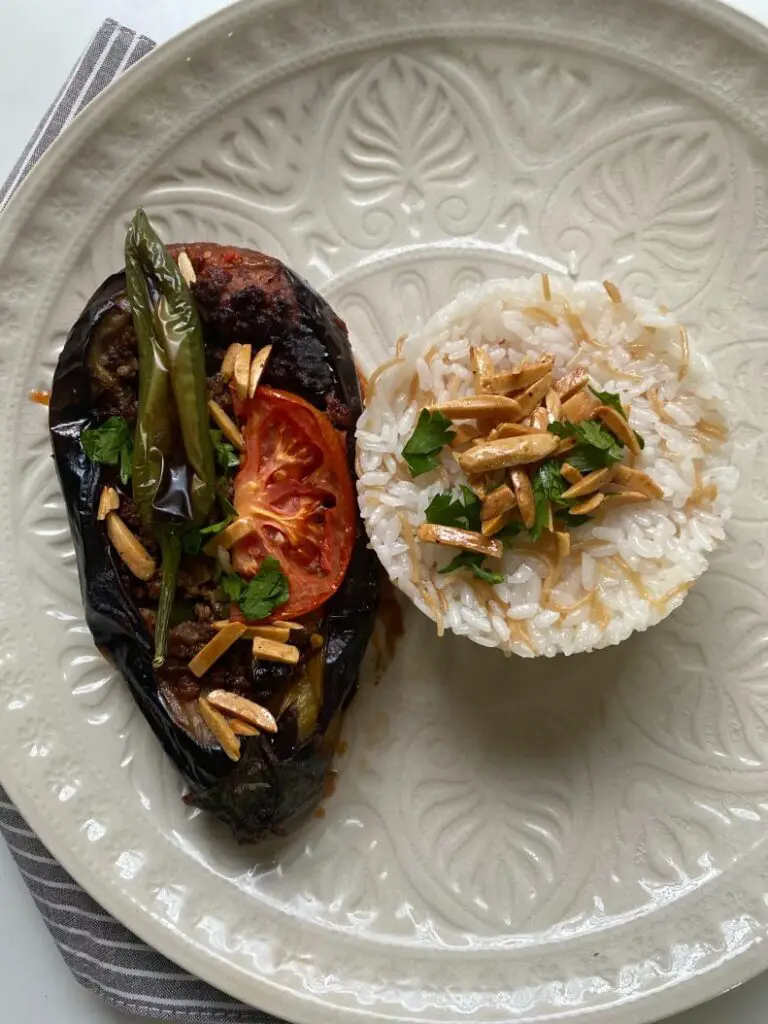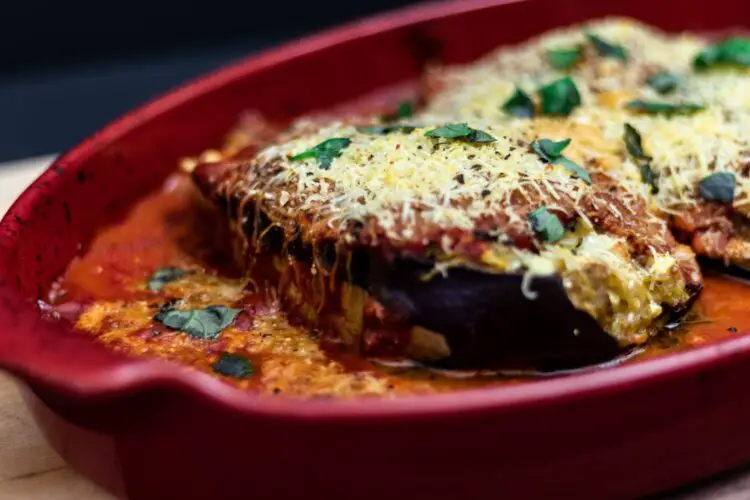Eggplant is a very popular vegetable all over the world. It has a unique texture and taste. This makes it great in many dishes, like Eggplant Parmesan and Baba Ganoush. While you can cook eggplant by frying, grilling, or baking it, microwaving is a fast and easy way to cook it too. This guide will teach you all about cooking eggplant in the microwave. It will help you make perfect eggplant dishes every time, even if you are new to cooking.
Microwaving is a good way to cook vegetables like eggplant. It keeps more nutrients in the eggplant. It doesn’t take a lot of watching or time. As we go through this guide, you’ll learn tips and tricks for cooking eggplant in the microwave. You’ll be able to make tasty and healthy eggplant dishes.
Benefits of Microwaving Eggplant
Microwaving has become a really popular way to cook for many families because it is fast and easy. When cooking eggplant, microwaving has some advantages:
- Time Efficiency – Microwaving eggplant takes just minutes. This makes it great for busy people or when you need to make a quick meal. Other cooking methods like boiling take way longer.
- Nutrient Retention – Microwaving keeps more of the vitamins and minerals in eggplant. Other cooking methods like boiling can make vegetables lose nutrients. But microwaving keeps more nutrients in.
- Less Oil Usage – Frying eggplant takes a lot of oil, which can add extra calories. Microwaving uses little or no oil, so it is healthier.
- Uniform Cooking – The microwave spreads heat evenly everywhere. This makes sure the eggplant cooks evenly all the way through. This is good for dishes where you want even texture.
While microwaving might not give eggplant the grilled or fried taste, it gives a good balance of healthy, fast, and tasty. For people who want more eggplant without spending lots of time cooking, microwaving is a game changer.
Types of Eggplants Suitable for Microwaving
Eggplants come in different shapes, sizes, and colors. Each type has its own taste and texture. While you can microwave most eggplants, knowing the differences can help you pick the best kind for your dish.
- Globe Eggplants – These are the most common eggplants found in stores. They are big, round, and purple. Their meaty texture holds up well when microwaved. This makes them good for dishes where you want a substantial bite.
- Japanese Eggplants – These are longer and thinner than globe eggplants. They have tender flesh and a slightly sweet taste. They cook quickly in the microwave, so watch them to prevent overcooking.
- Chinese Eggplants – These look like Japanese eggplants but are lighter purple. They have a delicate skin and creamy texture when cooked. They are good for dishes where you want a softer texture.
- Graffiti Eggplants – These are smaller with striped skin. Their size makes them perfect for quick microwave dishes. Their tender flesh soaks up flavors well.
- White Eggplants – These are white and usually smaller. They have a creamy texture and different flavor. They are unique choices for the microwave.
When choosing eggplants to microwave, pick firm, smooth ones without spots or bruises. No matter the type, adjust the cooking time based on size and thickness to get the right texture.

Microwave Baked Eggplant
Microwaving eggplant is a quick, easy way to cook this tasty vegetable. The steps are simple, and you get deliciously tender eggplant slices to use in dishes or eat on their own.
Recipe:
Ingredients:
- 1 medium eggplant
- 2 tablespoons olive oil
- 1/4 teaspoon salt
- 1/4 teaspoon pepper
- 2 tablespoons grated Parmesan cheese
Instructions:
- Wash the eggplant well. Cut off the stem end. Then slice it lengthwise into 1/2-inch slices.
- Put the slices in a single layer on a microwave-safe plate. Brush both sides with olive oil to add flavor. Season with salt and pepper.
- Cook uncovered on high power, 2-3 minutes per side depending on thickness. Cook until fork-tender.
- When done, sprinkle with Parmesan cheese. Microwave 1 more minute to melt the cheese.
- Let the eggplant stand 2-3 minutes after microwaving. This lets it finish cooking so it’s tender all the way through.
This method is fast and easy. In just 5-7 minutes, you have perfect steamed eggplant slices with flavor from oil and cheese. You can use them in dishes like eggplant Parmesan or eat them alone. Microwave-baked eggplant is sure to be a winner!
Preventing Mushy Microwaved Eggplant
Microwaving is a quick way to cook eggplant, but it can make eggplant mushy if not done right. Follow these tips to keep your microwaved eggplant from getting too soft:
Choosing the Right Eggplant
- Size and Shape – Pick smaller, skinny eggplants. Bigger, rounder ones have more moisture so get too soft in the microwave.
- Firmness – Choose an eggplant that’s firm and not overripe. It should resist when you press it and have glossy skin.
Prep Techniques
- Slicing – Cut slices no more than 1/2-inch thick so they cook evenly.
- Salting – Salt the slices and let sit for 30 minutes before cooking. This pulls out extra moisture that makes eggplant mushy. Pat dry after salting.
Microwaving Tips
- Spacing – Put slices in a single layer in the dish. Crowding makes them steam together and get soft.
- Check Often – Microwave for 1-2 minutes per side, checking texture frequently. Adjust the time based on thickness and microwave power.
- Resting – Let eggplant rest a few minutes after microwaving. Heat finishes cooking without making it mushy.
Following these guidelines gives you tender but firm microwaved eggplant. Whether in a dish or on its own, these tips ensure great texture every time.

Advanced Preparation Techniques
Before microwaving eggplant, there are some advanced prep methods to make it more flavorful and get a better texture. These can make a big difference in the final dish.
Salting and Draining – Salt the slices and let them sit for 30 minutes before cooking. This “sweating” takes out bitter juices and excess moisture. After salting, rinse and pat dry. It improves texture and makes less bitter flavor.
Marinating – Soak slices in a marinade of olive oil, garlic, herbs, and spices for at least 15 minutes before cooking. This gives more flavor and aroma to the dish.
Pre-cooking – For dishes with multiple cooking steps, pre-cook in the microwave first. For example, soften slices in the microwave before grilling. This reduces total cooking time and ensures doneness.
Skin On or Off? – The skin is edible and has nutrients. But some remove it because it can be bitter or tough, especially on big eggplants. Wash thoroughly if leaving the skin on. Otherwise, use a peeler or knife to remove it.
Adding these extra prep steps can make your microwaved eggplant even better tasting and textured. While they take a little more time, the results are worth it.
Best Ways to Cook Eggplant to Avoid Mushiness
Eggplant, with its spongy texture, can easily become mushy if not cooked correctly. While microwaving is a quick and efficient method, there are other techniques to retain the eggplant’s structure and offer a delightful bite.
Sautéing: One of the best ways to achieve a non-mushy texture is by sautéing. Start by slicing the eggplant into 1/2-inch thick rounds. After salting and letting them sit to draw out moisture, pat the slices dry. Heat olive oil in a skillet over medium-high heat and pan-fry the slices for 2-3 minutes per side until they’re browned. The high heat seals in the moisture and flavor, giving you a tender interior and a crispy exterior.
Roasting: Roasting prevents the eggplant from becoming too soft. Cut the vegetable into 1-inch cubes, toss them with oil, and roast at 425°F for 15-20 minutes. Ensure the pieces are in a single layer on a baking sheet to prevent steaming. Turning the cubes halfway through ensures even cooking. The slow evaporation of moisture concentrates the flavor without making the eggplant mushy.
Stir-Frying: For those who love Asian cuisine, stir-frying is an excellent method. Cut the eggplant into bite-sized pieces and salt them briefly to draw out some moisture. Using a wok or a large skillet, heat oil over high heat and stir-fry the eggplant for 1-2 minutes until they’re lightly browned but still crisp. Working in batches prevents the eggplant from stewing and becoming too soft.
Grilling: Grilling imparts a smoky flavor to the eggplant. Slice the eggplant, brush with oil, and grill each side for a few minutes. The direct heat from the grill chars the exterior while keeping the interior creamy.
In conclusion, while microwaving is a convenient method, combining it with other techniques or opting for alternative cooking methods can ensure your eggplant remains non-mushy.
Comparison of Microwaving Eggplant to Other Cooking Methods
When it comes to cooking eggplant, there are several methods available, each offering its unique taste and texture. Let’s compare microwaving to other popular cooking techniques:
| Method | Texture | Flavor | Key Features |
|---|---|---|---|
| Microwaving | Can be mushy or soft if overcooked. | Milder due to less browning. | A quick method that brings out nutty, meaty notes. |
| Sautéing | Retains some firmness; exterior can be crispy. | Rich and complex due to browning. | Retains some firmness; the exterior can be crispy. |
| Roasting | Creamy interior with a crispy exterior. | Deep and concentrated from caramelization. | Enhances natural sugars; gives a charred flavor. |
| Braising/Stewing | A slow cooking method suitable for stews and curries. | Absorbs flavors of the braising liquid. | Slow cooking method suitable for stews and curries. |
| Grilling | Creamy inside with a charred exterior. | Smoky flavor. | Best for thicker slices; imparts a unique grilled taste. |
In summary, while microwaving offers speed and convenience, methods like sautéing and roasting can provide superior flavor and texture. The choice of method often depends on the desired outcome of the dish. For instance, if you’re looking for a smoky flavor, grilling is the way to go. On the other hand, if you need a quick method to soften the eggplant for a dip or spread, microwaving is ideal.
Safety Tips for Microwaving Eggplant
Microwaving is a quick, easy way to cook eggplant. But like all cooking, you need to be safe. Following safety tips makes sure your eggplant turns out tasty without kitchen problems.
First, always use microwave-safe dishes. Materials like metal can cause sparks or fire in the microwave. Glass, ceramic, and some plastics are usually safe – check for a microwave-safe label.
Piercing the eggplant is important. For whole eggplants, poke the skin with a fork so steam can escape. This prevents bursting or exploding which makes a mess and can damage the microwave.
Watch cooking time closely. Overcooking gives a mushy texture and can make the eggplant super hot, burning you when you take it out. Microwave in short intervals and check texture to avoid overcooking.
After microwaving, let the eggplant stand for a few minutes. This lets the heat spread evenly to ensure doneness. It also cools a bit so you don’t burn your hands.
In summary, microwaving eggplant is straightforward but focus on safety. Use the right dishes, pierce the vegetable, monitor cooking time, and let it rest after cooking. These steps give safe, delicious results.
Seasoning Microwaved Eggplant
Eggplant, with its mild and somewhat neutral flavor, acts as a canvas for a plethora of seasonings and flavors. When microwaved, its texture becomes soft and tender, making it even more receptive to the seasonings you choose. Here’s how to season your microwaved eggplant to perfection:
| Type of Seasoning | Flavor Profile | Suggested Use |
|---|---|---|
| Mediterranean Flavors | Olive oil, garlic, oregano, basil, parsley, lemon | Ideal for a light, fresh taste reminiscent of Mediterranean cuisine. |
| Asian Flavors | Soy sauce, sesame oil, garlic, ginger | Perfect for giving your eggplant a savory, umami-rich flavor. |
| Middle Eastern Spices | Cumin, coriander, cinnamon, allspice | These spices impart a warm, aromatic flavor to the eggplant. |
| Herbs and Spices | Rosemary, thyme, sage, garlic | Fresh herbs elevate the natural flavors of the eggplant. |
It’s essential to season the eggplant both before and after microwaving. Before cooking, a light seasoning helps infuse the eggplant with flavor as it cooks. After microwaving, a final touch of seasoning can enhance the dish’s overall taste. Remember, eggplant is like a sponge, and it will absorb the flavors you introduce to it.
When experimenting with seasonings, always start with a light hand and adjust according to your taste. The versatility of eggplant allows it to pair beautifully with a variety of cuisines, from Italian to Chinese. Whether you’re making a simple side dish or a main course, the right seasonings can transform your microwaved eggplant into a culinary delight.

Common Mistakes When Microwaving Eggplant
Microwaving eggplant is pretty easy, but there are some common mistakes that can mess up the results. Knowing these errors and how to avoid them gives perfect eggplant every time.
- Not piercing the skin – Big mistake is not poking holes in the skin before microwaving. The skin traps steam inside, making the eggplant explode. Always pierce the skin with a fork so steam can escape.
- Overcooking – Going too long makes a mushy texture. Watch cooking time closely based on size and thickness. Use short bursts and check doneness often to prevent overcooking.
- Too high power – Full power can cause uneven cooking. Adjust the power setting by recipe or eggplant size and thickness.
- No resting period – It’s important to let eggplant stand a few minutes after microwaving. This lets heat finish cooking evenly and makes it easier to handle.
By avoiding these common errors, your microwaved eggplant will turn out perfectly cooked. Whether a simple side or complex recipe, taking these precautions means delicious results.
Creative Recipe Ideas for Microwaved Eggplant
Microwaved eggplant isn’t just a quick side – it can star in many creative recipes. Its versatility lets you use it in different cuisines for tasty, textured meals. Here are innovative ways to use microwaved eggplant:
- Eggplant Dip – Microwave a whole eggplant until soft. Scoop out the flesh and blend with tahini, garlic, lemon, and olive oil for a creamy dip with pita bread or sandwiches.
- Eggplant Parmesan – Layer microwaved slices with marinara, mozzarella, and parmesan. Broil-to-melt cheese for a quick version of this classic.
- Eggplant and Chickpea Salad – Dice microwaved eggplant and mix with chickpeas, cherry tomatoes, red onion, and lemony dressing for a hearty, healthy salad.
- Stuffed Eggplant – Microwave a whole eggplant until slightly soft. Cut in half, scoop out some flesh to mix with quinoa, tomatoes, and spices. Stuff back into the eggplant for a wholesome meal.
- Eggplant Tacos – Use microwaved slices as taco bases. Top with beans, corn, avocado, and lime crema for meatless tacos.
Eggplant is so versatile. It can be plain or spiced up, a main or side dish. Starting with the microwave lets you get creative fast.
Pairing Microwaved Eggplant with Other Foods
Eggplant, with its mild and versatile flavor, pairs beautifully with a variety of foods. Whether you’re looking for a complementary side dish or want to incorporate eggplant into a main course, here are some foods that go exceptionally well with microwaved eggplant:
- Grains: Quinoa, rice, and couscous are grains that can be served alongside or mixed with microwaved eggplant. Their neutral taste balances the eggplant’s flavor, and they add a delightful texture contrast.
- Proteins: Grilled chicken, lamb, or tofu can be paired with microwaved eggplant for a hearty meal. The eggplant can act as a side or be used in a sauce or stew with these proteins.
- Vegetables: Bell peppers, zucchini, and tomatoes are vegetables that complement the taste and texture of eggplant. Consider making a roasted vegetable medley with microwaved eggplant as one of the key ingredients.
- Cheeses: Feta, mozzarella, and parmesan cheese enhance the flavor of microwaved eggplant. Whether you’re sprinkling some feta on top or layering slices with mozzarella for a quick eggplant parmesan, cheese is a delightful addition.
- Herbs and Spices: Basil, oregano, parsley, and garlic are just a few herbs that elevate the taste of microwaved eggplant. Spices like cumin, coriander, and chili powder can also be used to give a different flavor profile to the dish.
- Sauces: Tomato sauce, tahini, and tzatziki are sauces that can be drizzled over or served alongside microwaved eggplant. They add moisture, and flavor, and can transform the dish.
When pairing foods with microwaved eggplant, consider the dish’s overall flavor profile. Whether you’re aiming for a Mediterranean, Asian, or classic American taste, eggplant can seamlessly fit into various cuisines and dishes.

Conclusion and Final Thoughts
Eggplant, with its versatile nature and ability to absorb flavors, is a delightful vegetable to experiment with in the kitchen. Microwaving, in particular, offers a quick and efficient method to prepare this vegetable, especially when time is of the essence. While it might not provide the depth of flavor achieved by methods like roasting or grilling, it certainly holds its own in terms of convenience and speed.
However, as with any cooking method, it’s essential to approach microwaving with knowledge and care. By understanding the nuances of the microwave, selecting the right type of eggplant, and using the correct seasoning and preparation techniques, you can achieve delicious results. Whether you’re making a simple side dish, a creamy baba ganoush, or incorporating it into a more complex recipe, microwaved eggplant can be a delightful addition to your culinary repertoire.
In summary, don’t be afraid to explore the possibilities of microwaved eggplant. With the proper techniques, safety precautions, and creative vision, you can take this versatile vegetable on a culinary journey that will leave your taste buds delighted and craving for more!
Printable Recipe Card
Want just the essential recipe details without scrolling through the article? Get our printable recipe card with just the ingredients and instructions.

